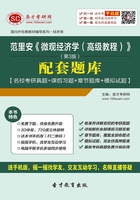
第3章 利润函数
1.一个竞争性的利润最大化厂商有利润函数 。将产出价格正规化,令其等于1。
。将产出价格正规化,令其等于1。
(a)对函数 求一阶导数和二阶导数,可以得到什么结论?
求一阶导数和二阶导数,可以得到什么结论?
(b)如果 是对要素
是对要素 的要素需求函数,
的要素需求函数, 的符号是什么?
的符号是什么?
(c)令 为产生这种形式的利润函数的生产函数。这种生产函数的形式是什么样子的?(提示:参见一阶条件)
为产生这种形式的利润函数的生产函数。这种生产函数的形式是什么样子的?(提示:参见一阶条件)
A competitive profit-maximizing firm has a profit function  .The price of output is normalized to be 1.
.The price of output is normalized to be 1.
(a)What do we know about the first and second derivatives of the functions  ?
?
(b)If  is the factor demand function for factor
is the factor demand function for factor  , what is the sign of
, what is the sign of  ?
?
(c)Let  be the production function?(Hint:look at the first-order conditions.)
be the production function?(Hint:look at the first-order conditions.)
答:(a)由利润函数的凸性得到 ,从而可知
,从而可知 ;又因为利润函数关于要素价格是单减的,即
;又因为利润函数关于要素价格是单减的,即 ,从而可知
,从而可知 。
。
(b)根据Hotelling引理可知 ,因此
,因此 。
。
(c)由(b)可知 ,又因为对
,又因为对 ,
, 恒成立。
恒成立。
从 中反解出
中反解出 代入上式中可知
代入上式中可知 只和
只和 有关;同理可知
有关;同理可知 只和
只和 有关,从而可知
有关,从而可知 一定可以写成如下形式:
一定可以写成如下形式: 。
。
2.考虑 ,
, 和
和 ,
, 所描述的技术。计算出这种技术的利润函数。
所描述的技术。计算出这种技术的利润函数。
Consider the technology described by  for
for  and
and for
for  . Calculate the profit function for this technology.
. Calculate the profit function for this technology.
解:令 ,易知
,易知 在区间
在区间 上单增,在区间
上单增,在区间 上单减,所以
上单减,所以 在
在 这一点上达到最大值。下面分情况讨论:
这一点上达到最大值。下面分情况讨论:
(1)当  时,如果厂商停产,那么它的利润就是零;如果厂商继续生产,那么当它的产量为1时,可以得到最高利润为
时,如果厂商停产,那么它的利润就是零;如果厂商继续生产,那么当它的产量为1时,可以得到最高利润为 。所以,厂商的最优选择就是不生产。
。所以,厂商的最优选择就是不生产。
(2)当 时,如果厂商停产,那么它的利润就是零;如果厂商继续生产,那么当它的产量为
时,如果厂商停产,那么它的利润就是零;如果厂商继续生产,那么当它的产量为 时,可以得到最高利润,为
时,可以得到最高利润,为 。所以如果
。所以如果 即
即 时,厂商应当选择生产
时,厂商应当选择生产 数量的产品,相应的利润为
数量的产品,相应的利润为 ;如果
;如果 ,那么厂商应当选择停产,此时的利润为零。
,那么厂商应当选择停产,此时的利润为零。
综上可知,厂商的利润函数为:

如图3-1所示。

图3-1 厂商的利润最大化
3.给出生产函数 ,计算出利润最大化的需求和供给函数,以及利润函数。为简单起见,假定存在内解。假定
,计算出利润最大化的需求和供给函数,以及利润函数。为简单起见,假定存在内解。假定 。
。
Given the production function  ,calculate the profit-maximizing demand and supply functions,and the profit function. For simplicity assume an interior solution. Assume that
,calculate the profit-maximizing demand and supply functions,and the profit function. For simplicity assume an interior solution. Assume that  .
.
解:利润最大化问题:

一阶条件为:

得出要素需求方程为: ,
, 。
。
将要素需求方程代入生产函数 ,得到供给函数:
,得到供给函数:

将要素需求方程代入目标函数 就得出利润函数:
就得出利润函数:

4.给出生产函数 ,计算出利润最大化的需求和供给函数,以及利润函数,假定
,计算出利润最大化的需求和供给函数,以及利润函数,假定 。
。 和
和

必须满足什么样的约束?
Given the production function  ,calculate the profit-maximizing demand and supply functions, and the profit function. Assume
,calculate the profit-maximizing demand and supply functions, and the profit function. Assume  . What restrictions must
. What restrictions must  and
and  satisfy?
satisfy?
解:利润最大化问题:
一阶条件是:

解得要素需求函数:

将要素需求函数代入目标函数 即求得利润函数:
即求得利润函数:

当 时,生产函数规模报酬递增,所以不存在最大利润;当
时,生产函数规模报酬递增,所以不存在最大利润;当 时,得到柯布—道格拉斯生产函数,所以不存在最大利润;当
时,得到柯布—道格拉斯生产函数,所以不存在最大利润;当 时,优化问题的海赛矩阵负定,所以存在最大利润。
时,优化问题的海赛矩阵负定,所以存在最大利润。
综上可知 时,利润最大化问题有解。
时,利润最大化问题有解。
5.给出生产函数 ,计算出利润最大化的需求和供给函数,以及利润函数。
,计算出利润最大化的需求和供给函数,以及利润函数。 必须满足什么约束?
必须满足什么约束?
Given the production function  , calculate the profit -maximizing demand and supply functions, and the profit function. What restriction must a satisfy?
, calculate the profit -maximizing demand and supply functions, and the profit function. What restriction must a satisfy?
解:厂商的利润最大化问题为:

对于最优解必有 ,所以上述最优化问题可以化简为:
,所以上述最优化问题可以化简为:

从而解得要素需求函数为:

将要素需求函数代入生产函数得到供给函数:

将要素需求函数代入目标函数得到利润函数:

上述最优化问题的二阶条件为 ,可见为了满足二阶条件必须有
,可见为了满足二阶条件必须有 ;当
;当 时,生产函数规模报酬递增,所以不存在最大利润;当
时,生产函数规模报酬递增,所以不存在最大利润;当 时,只有当
时,只有当 时,厂商有最大利润(等于零),当
时,厂商有最大利润(等于零),当 时,厂商无最大利润;综上可知:当
时,厂商无最大利润;综上可知:当 时,厂商的利润函数处处存在。
时,厂商的利润函数处处存在。